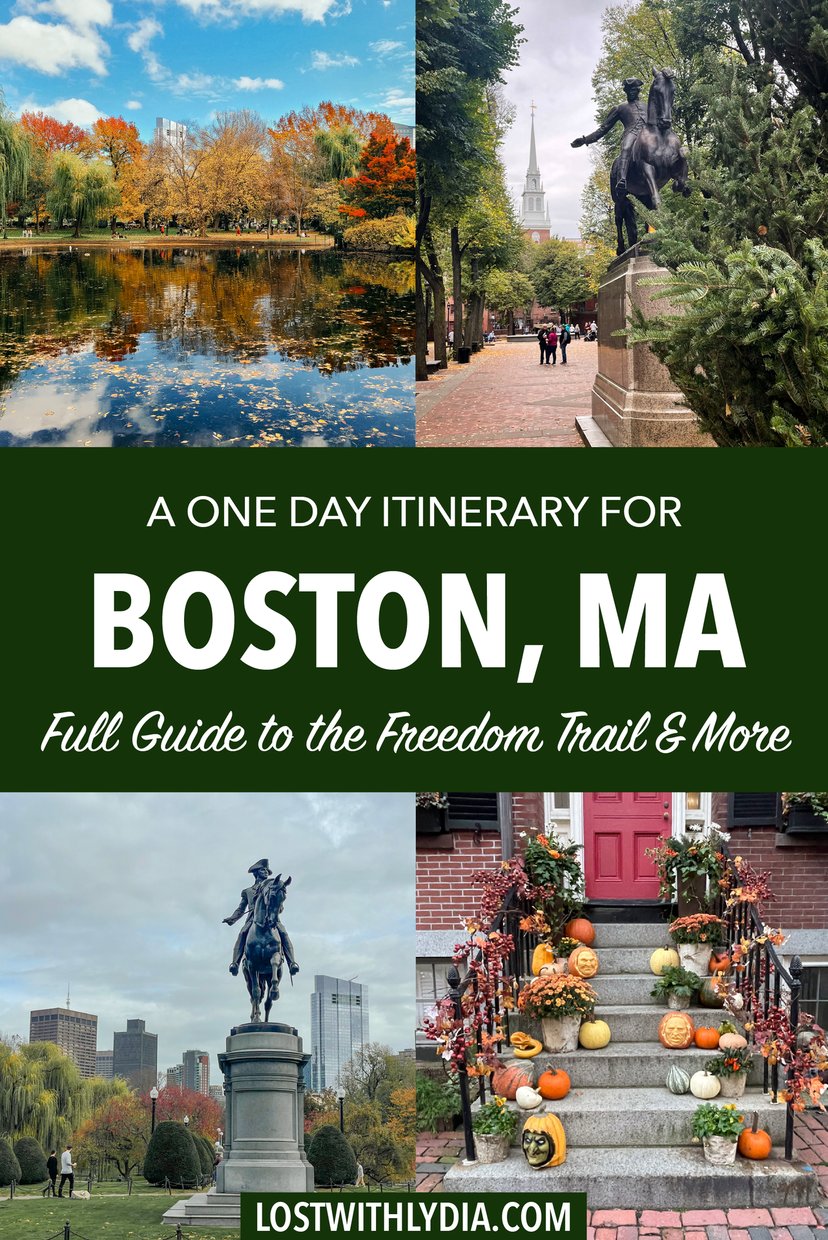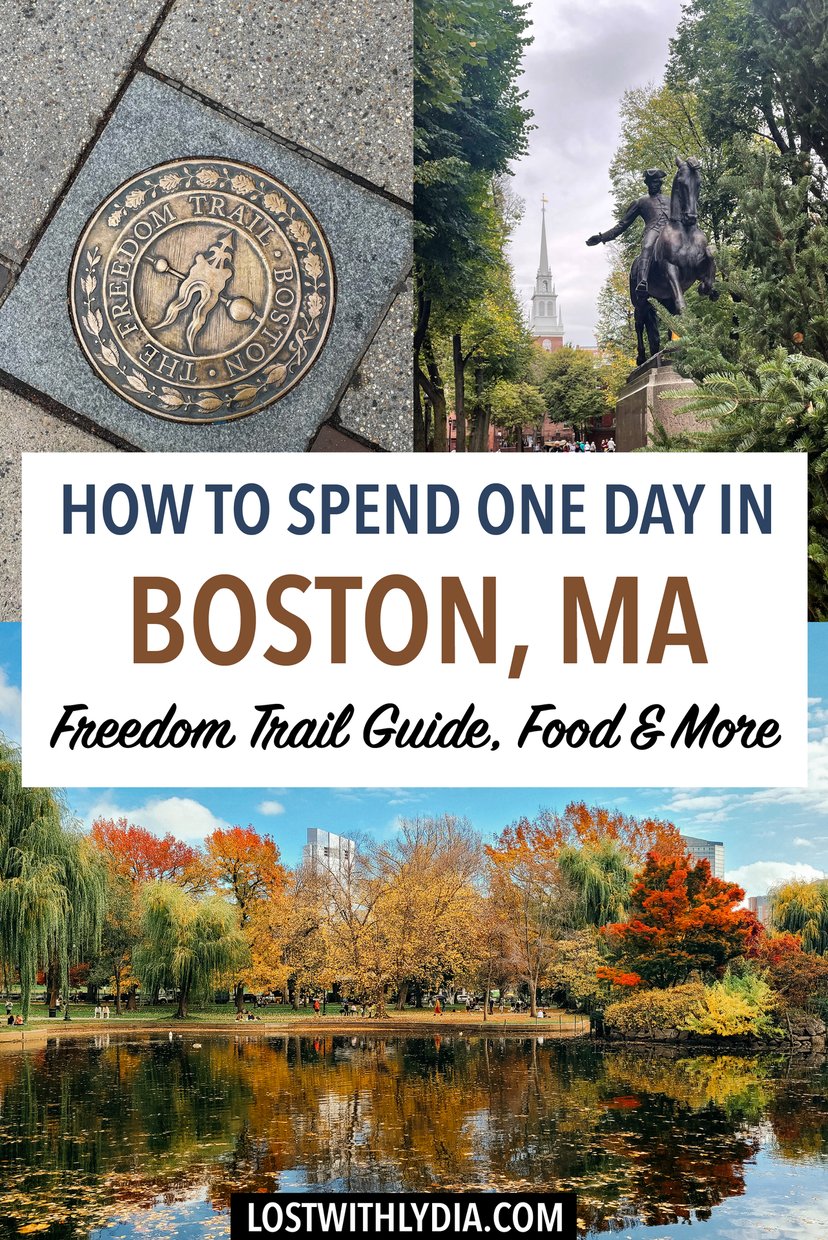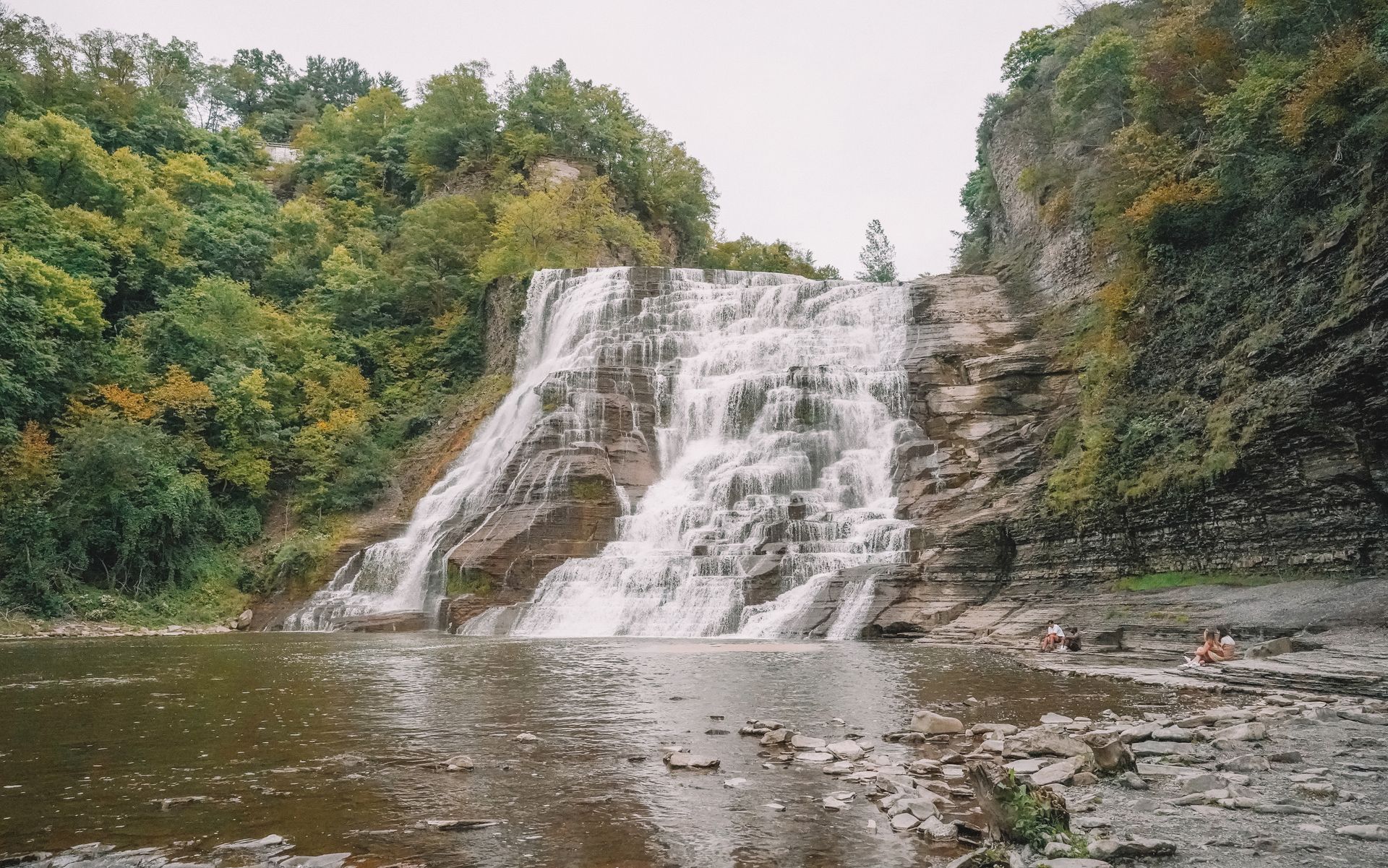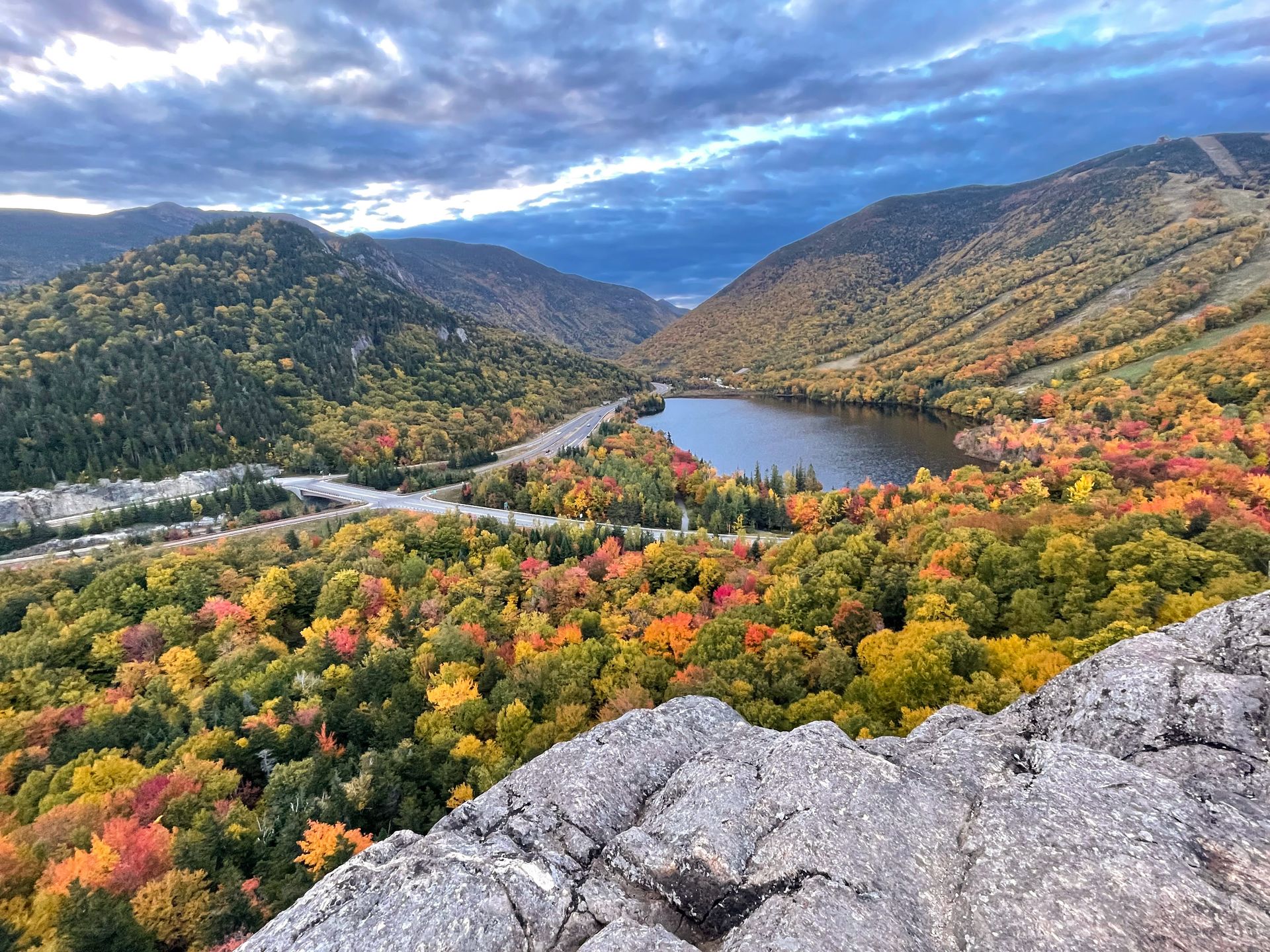How to Spend One Day in Boston: Full Guide to the Freedom Trail & More
November 12, 2022
Boston is a storied city full of delectable Italian food, important historic sites and beautiful architecture. A walk on the Freedom Trail, with some great food along the way, is sure to transport you back 100’s of years to the birth of the United States.
If it’s your first time in Boston and you’re looking for a one day itinerary, you’re in the right place! This guide includes a full guide to walking the Freedom Trail, the best food near the Freedom Trail and other tips along the way. Note that this itinerary involves a lot of walking, be sure to wear comfortable shoes!
This blog is based on my experience spending a month in Boston in November 2022.
Boston One Day Itinerary
Discover the best things to do in Boston if you only have one day! Here is a summary of this Boston one day itinerary:
- Have breakfast near the start of the Freedom Trail
- Visit the Boston Public Library
- Take a quick walk around Beacon Hill
- Walk the 2.5 mile long Boston Freedom Trail
- Have lunch at the Boston Public Market
- Have dinner in the North End
Breakfast Near the Start of the Freedom Trail
Start with a filling breakfast to get ready for a day full of walking and exploring! Here are three breakfast options near the start of your day.
Flour Bakery is a Boston chain with a location not far from the start of the Freedom Trail (on Clarendon Street). They serve a large menu of pastries and breakfast items and are even led by a James Beard Award-winning pastry chef. I loved the breakfast sandwich with egg souffle, arugula, guacamole, cheese and tomato!
Another great place for breakfast nearby is the Friendly Toast. This popular brunch spot serves vegan options, mimosa flights, chicken and waffles and more. Expect a wait and get there early, but this is a good choice if you’re looking for something fun!
Finally, a third option is Mike and Patty’s, which is known for their delectable breakfast sandwiches such as the ‘Fancy’ and ‘Grilled Crack.’ They are one of the highest rated places for breakfast sandwiches in the city!
Boston Public Library
Start your day with a visit to the beautiful and expansive Central Boston Public Library. The library typically opens at 9:00AM Monday - Saturday and opens later on Sundays. I recommend arriving close to the opening to start your day.


The Boston Public Library system was first established in 1848, making it the oldest, largest free municipal library in the US. It was also the first public library to lend books, have branches and have a children’s room.
The Central Library is made up of two attached buildings - one built in 1895 and a more modern wing built in 1972 (and renovated in 2016). The most famous portion that you’ll see in photos is the Bates Hall. This iconic reading room has high arched windows and is 218 feet long, 42 feet wide and 50 feet tall. It’s a beautiful room where you can read a book, work on a laptop or just take in the view. Just be sure to be quiet and respectful of others.
The Bates Hall is located on the second floor and the staircase leading up to it is also stunning. While you’re here, also check out the courtyard that separates the historic and the more modern parts of the library.
If you are interested in architecture, the Boston Public Library Central branch is definitely worth a stop on your Boston itinerary.
Optional: Explore Beacon Hill and Visit Acorn Street
Just north of the start of the Freedom Trail is the beautiful Beacon Hill neighborhood. Here you’ll find cobblestone streets, brick row houses and antique lanterns. The most famous street in the neighborhood is Acorn Street, said to be the most photographed street in the city (and perhaps the nation).

Acorn Street gets very crowded and there are sometimes signs asking visitors not to trespass. Be sure to respect the residents by moving quickly and quietly if you visit.
Walk the Freedom Trail
The Boston Freedom trail is a 2.5-mile route that passes 16 historically significant locations in United States history. You can follow the route around the city by looking for the line of red bricks that connects all of the sites.
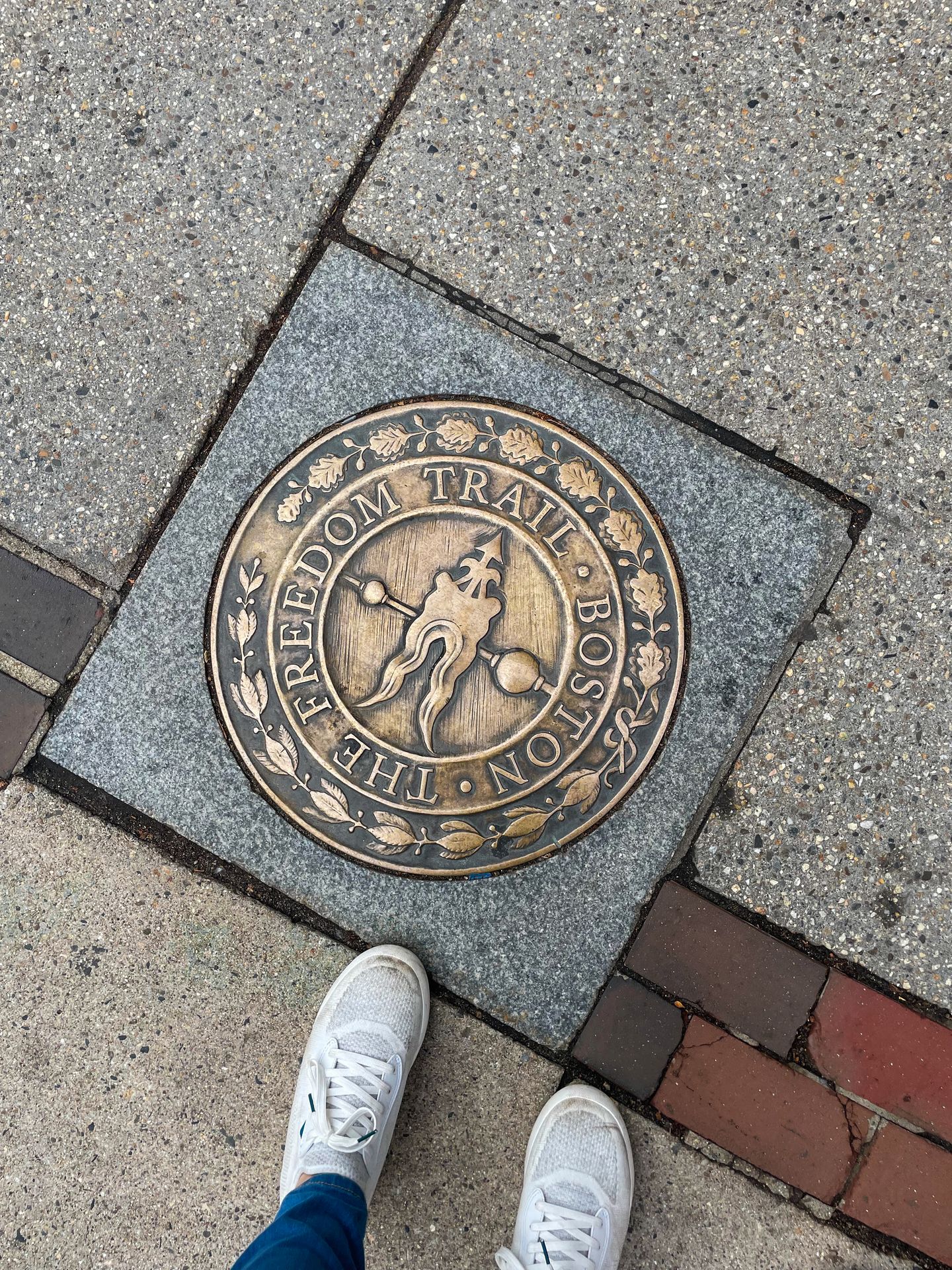

Some locations cost admission to enter, while others are free. If you want to learn from a guide along the way, there are many different tours offered. You can find traditional historic walking tours, pub crawls, lantern tours that focus more on the dark side of history and more. Note that most tours do not cover the entire Freedom Trail, only a portion.
I opted to do a self guided walking tour and read about the destinations along the way. I also choose to pay to go into only a couple spots. If you’re interested in doing a self guided Freedom trail walk, keep reading for more information on each location!
Tip: Download the free Freedom trail brochure to read about the various locations along the way. Or download the Guide Along tour if you prefer an audio guide.
Read my full guide to walking the Boston Freedom Trail
Boston Common
Begin your walk on the Freedom Trail at Boston Common. Established in 1634, this is America’s oldest public park.
The land for the park was purchased by Puritan colonists and used as a “Common Land” for local livestock until 1830. Later in history, the land was used as a “trayning field” for Redcoats during their occupation of Boston in 1775. As the years went on, the land has been used in many instances for discourse and public demonstrations, such as a civil rights rally held by Martin Luther King Jr, Vietnam War protest rallies, a Mass by Pope John Paul II and more.

The Freedom Trail officially begins here in the park at the Boston Common Visitor Center. The visitor center has souvenirs, restrooms and informational brochures. Before you start the trail here, I recommend exploring the park a bit.
Don’t miss the Public Garden, where you’ll see sculptures, a pond and beautiful landscaping. This is technically located across the street from Boston Common and offers Swan Boats to drive around the pond in the warmer months.
Also take a look at the Earl of Sandwich, a unique building that was formerly used as a men’s restroom in the early 1900’s. The fast food sandwich chain spent over a million dollars to renovate the building to what it is today.
After exploring the park, follow the red bricks from the visitor center to the Massachusetts State house as you begin your historic walk around Boston.

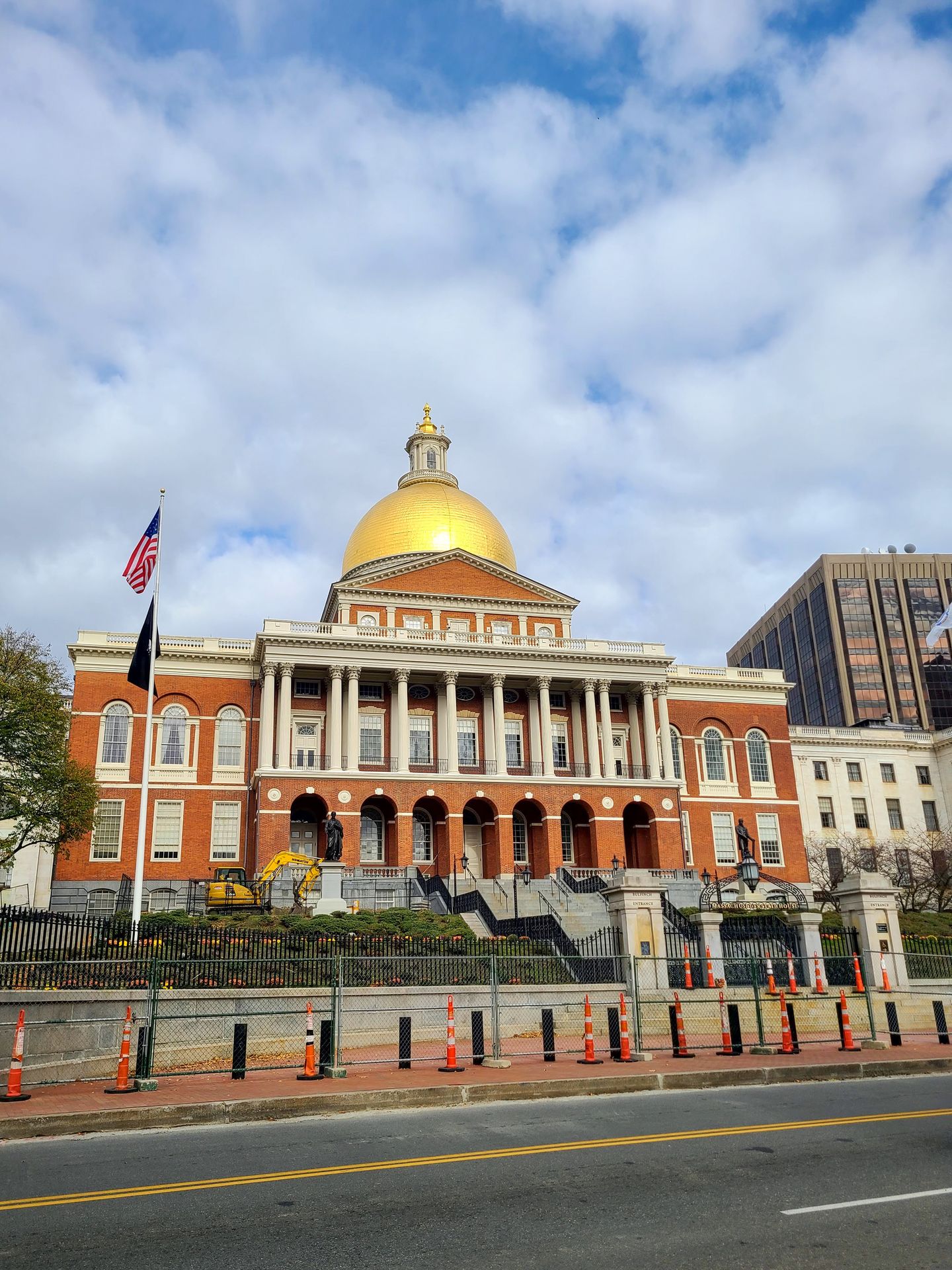
Massachusetts State House
The Massachusetts State House opened in 1798 and has been home to the Massachusetts legislative and executive branches ever since. The building is free to enter on weekdays, but closed on weekends and holidays. If you schedule in advance, you can also take a free tour of the state house.
Since I visited on a weekend, I enjoyed the view from outside and then continued to stop number three.
Park Street Church
The Park Street Church is an historic site in Boston that is over 200 years old. It was founded in 1809 and was once one of the first landmarks a visitor would see on their trip to Boston.
Throughout history, there have been talks of prison reform, women’s suffrage and impassioned protests against slavery inside the church. The church also held onto brimstone (a part of gunpowder) in the basement during the War of 1812.
You can visit the inside of the church seasonally. In 2022, it was open to the public from the end of June to the end of August. They also offer Sunday Services open to all.
Granbury Burying Ground
Right next door to the Park Street Church, you’ll find the Granbury Burying Ground. In my opinion, this is one of the most interesting stops on the trail. The cemetery has the gravestones of many notable figures, including John Hancock, Samuel Adams, Paul Revere and the parents of Benjamin Franklin. This is also a grave marker for the victims of the Boston Massacre.
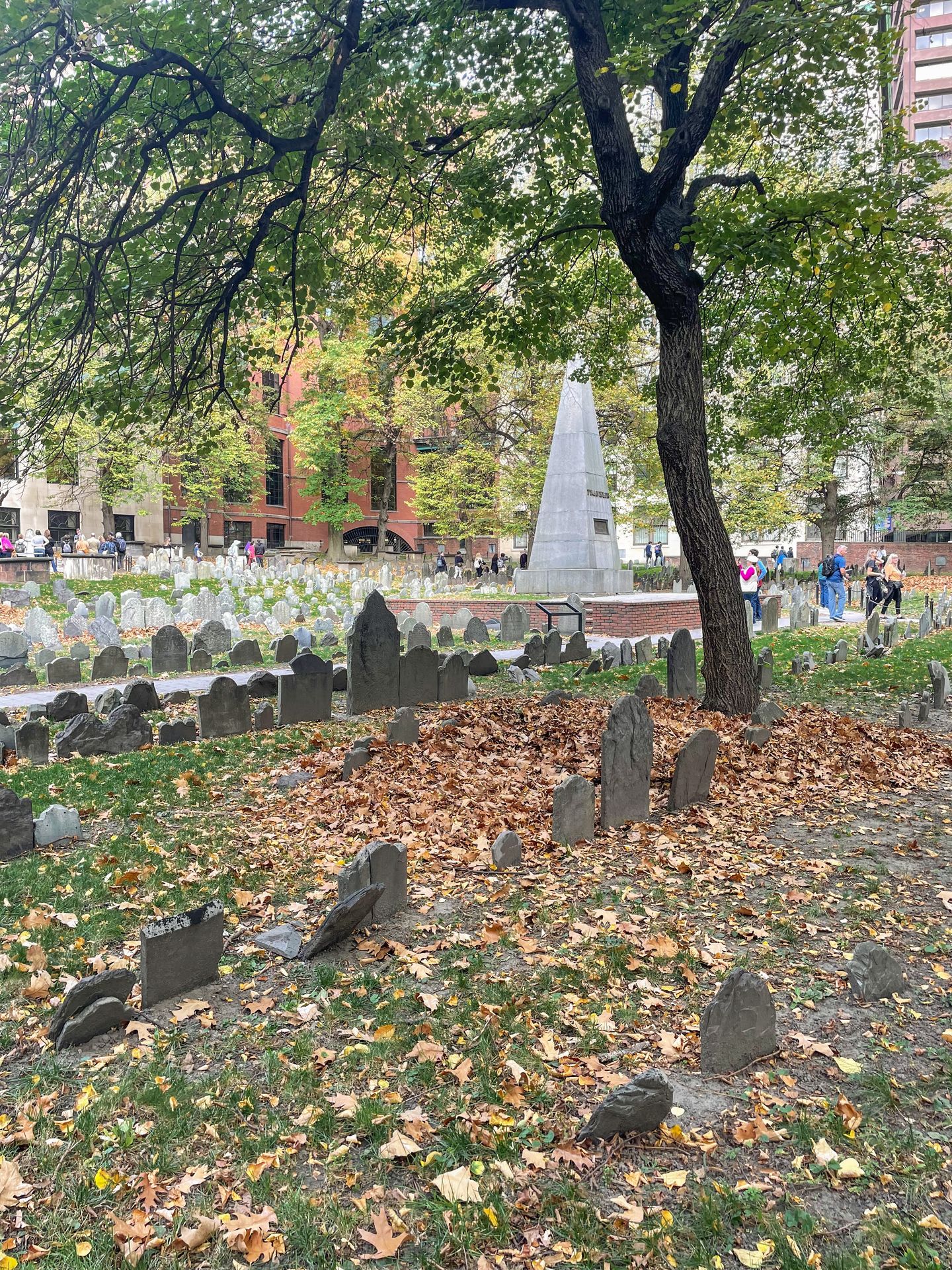
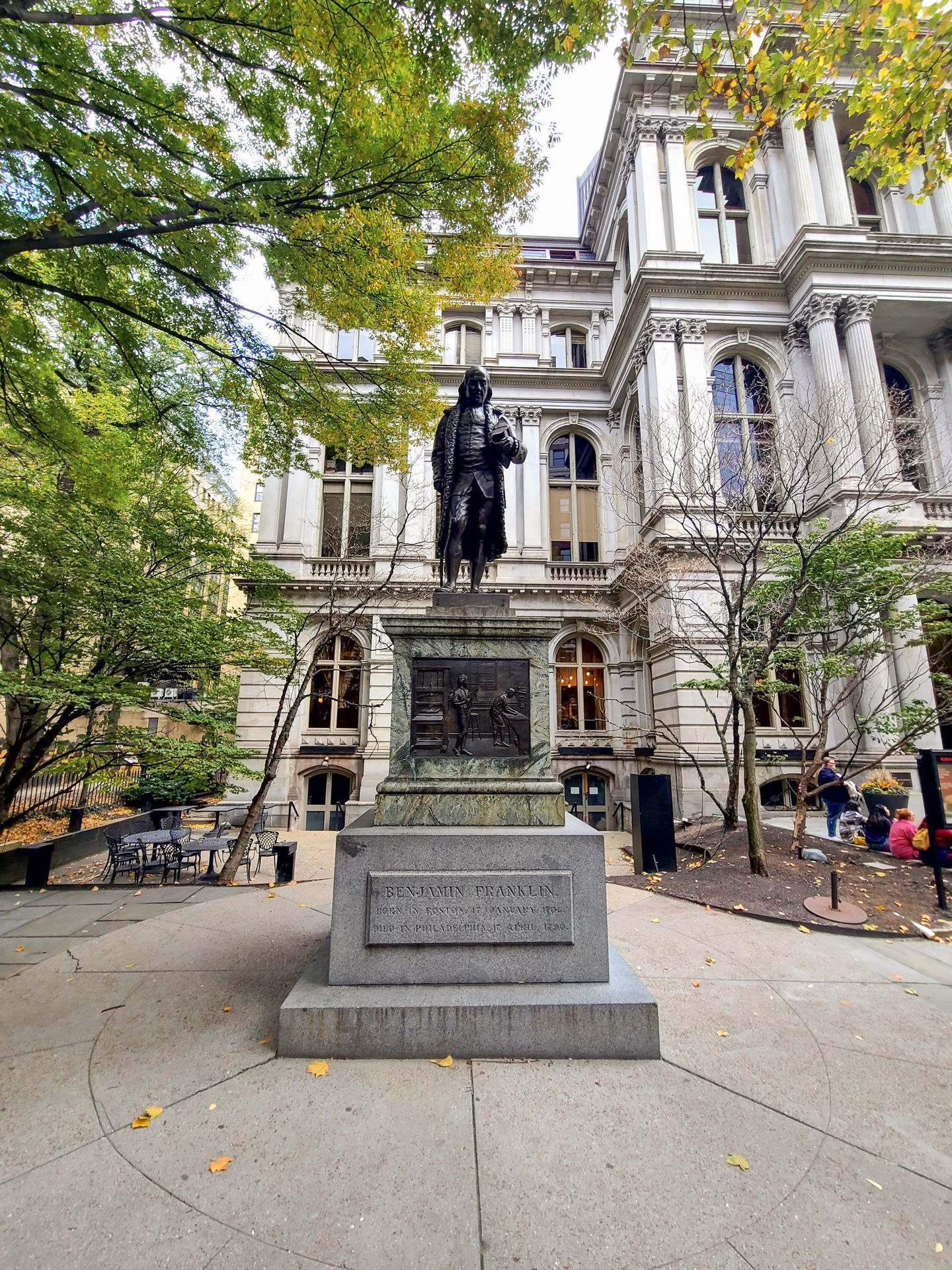
The burying ground is typically open from 9 AM to 4 PM and is free to enter. When I visited, a man (Jimmy Cole from historybuddies.com) was handing out pamphlets full of information about the grounds. I’m not sure if this is officially allowed, but I found it to be helpful in learning about the history and the location of notable graves. He accepted tips but did not expect them.
This historic burying ground is not to be missed while exploring the Freedom Trail.
King’s Chapel and King’s Chapel Burying Ground
King’s Chapel and King’s Chapel Burying Ground are located right down the street from Granbury Burying Ground and Park Street Church. The cemetery is free to visit, but it costs $5 to enter the chapel. The burying ground was the first one in Boston and is the home of John Winthrop, Mary Chilton (the first woman to step off the Mayflower) and others.
I did not pay to enter the chapel but it is one of the oldest churches in Boston and has multiple exhibits to explore.
Boston Latin School Site
Behind the King’s Chapel, you’ll find a square, statue and mosaic that mark the location of what was once the Boston Latin School. The school was founded in 1635 and is the oldest public school in America.
Five signers of the Declaration of Independence attended Boston Latin, but one, Benjamin Franklin, actually dropped out. Even so, a statue of Benjamin Franklin marks the location of the former schoolhouse. The school still operates today in other locations around the city.
Old Corner Bookstore
This stop on the Freedom Trail is just a quick destination to admire. It is the site of the Old Corner Bookstore and is Boston’s oldest commercial building. It was home to the publisher Ticknor and Fields, which produced notable titles such as The Scarlet Letter, Walden and more.
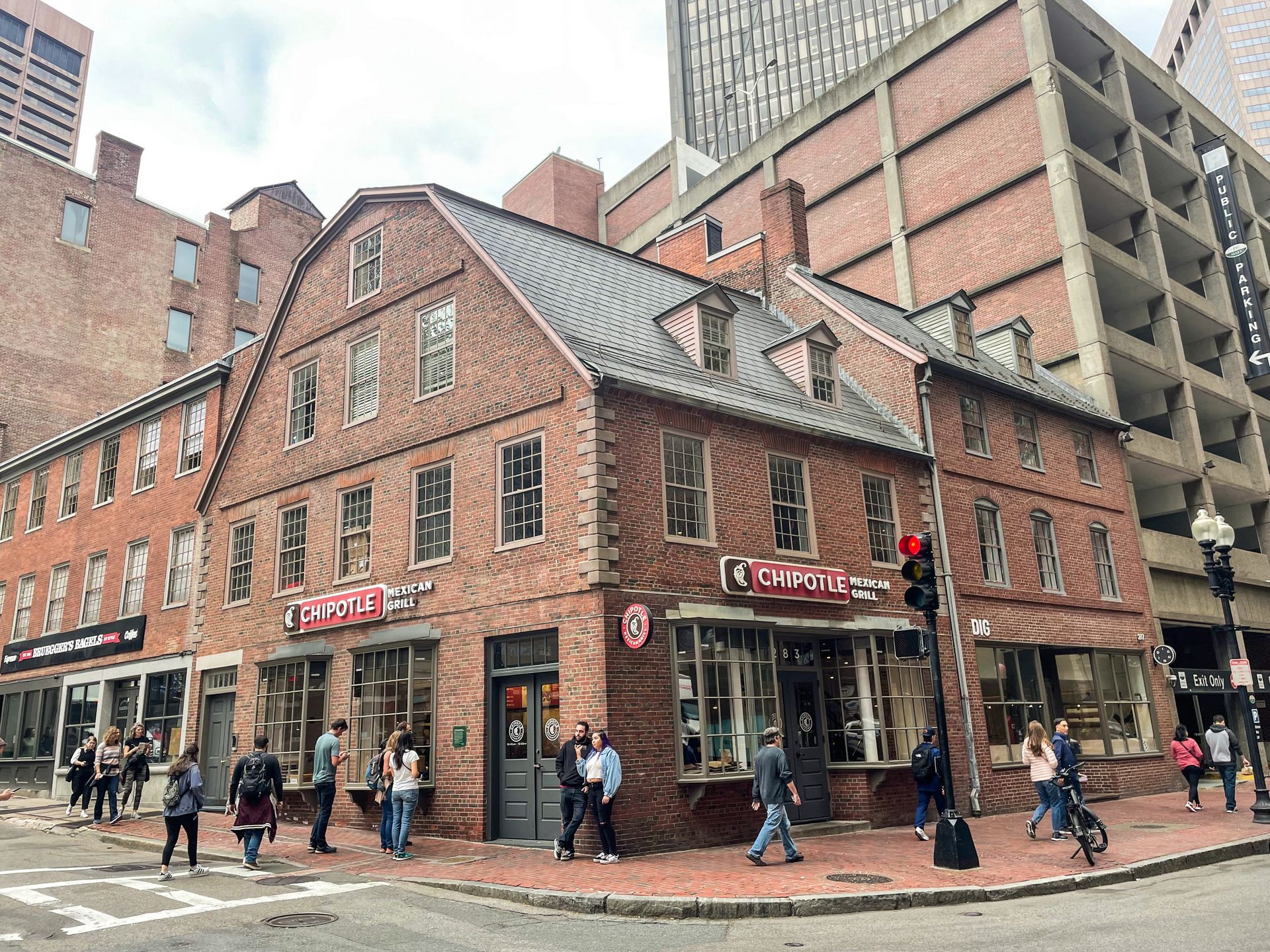
It was originally constructed in 1718 and saved from demolition in 1960. Today, the building is a Chipotle, and if I’m being honest, the giant “Chipotle” signs take away from the historic appeal. At least the leases help pay for other historic preservation projects around the city.
Old South Meeting House
Practically across the street from the Old Corner Bookstore is the Old South Meeting House. This is the location of many important meetings and protests against British actions leading up to the revolution. Most notably, this is where 5,000 men debated the controversial tea tax in 1773. When they could not compromise, Samuel Adams gave the signal to begin the Boston Tea Party. This led to the start of the American Revolution.
The Old South Meeting House is a partner site of the Boston National Historical Park and costs $15 per adult. The same ticket can be used at the Old State House. I opted not to go inside, but there are some interesting exhibits about the history.
Old State House
The Old State House is the oldest surviving public building in Boston and the next stop on the Freedom Trail. The building was first built in 1713 and served as a center for public life. The Boston Massacre occurred just outside of this building.
It costs $15 to enter and can also be used at the Old South Meeting House. The museum tells of the events that led up to the Revolutionary War.
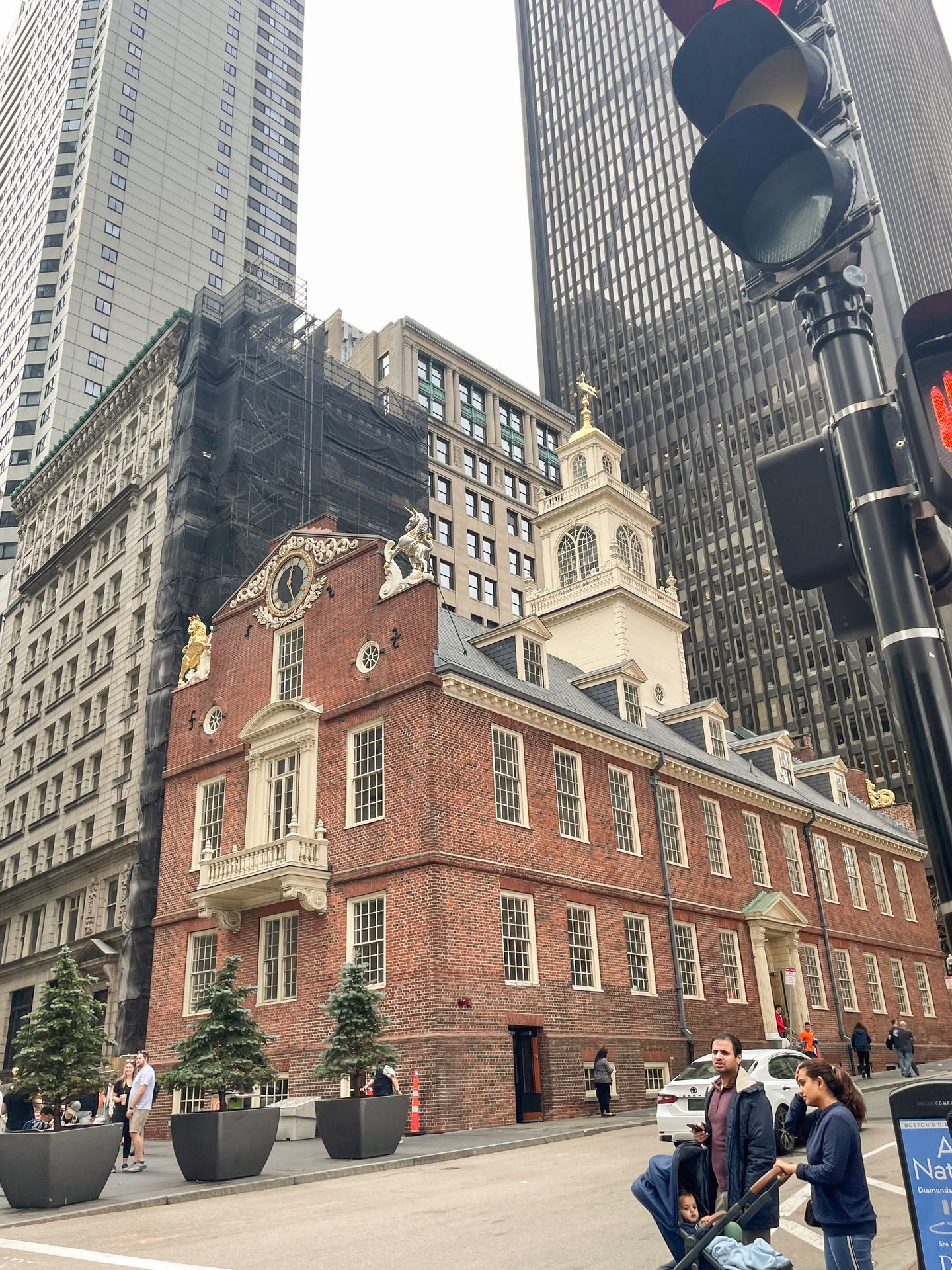
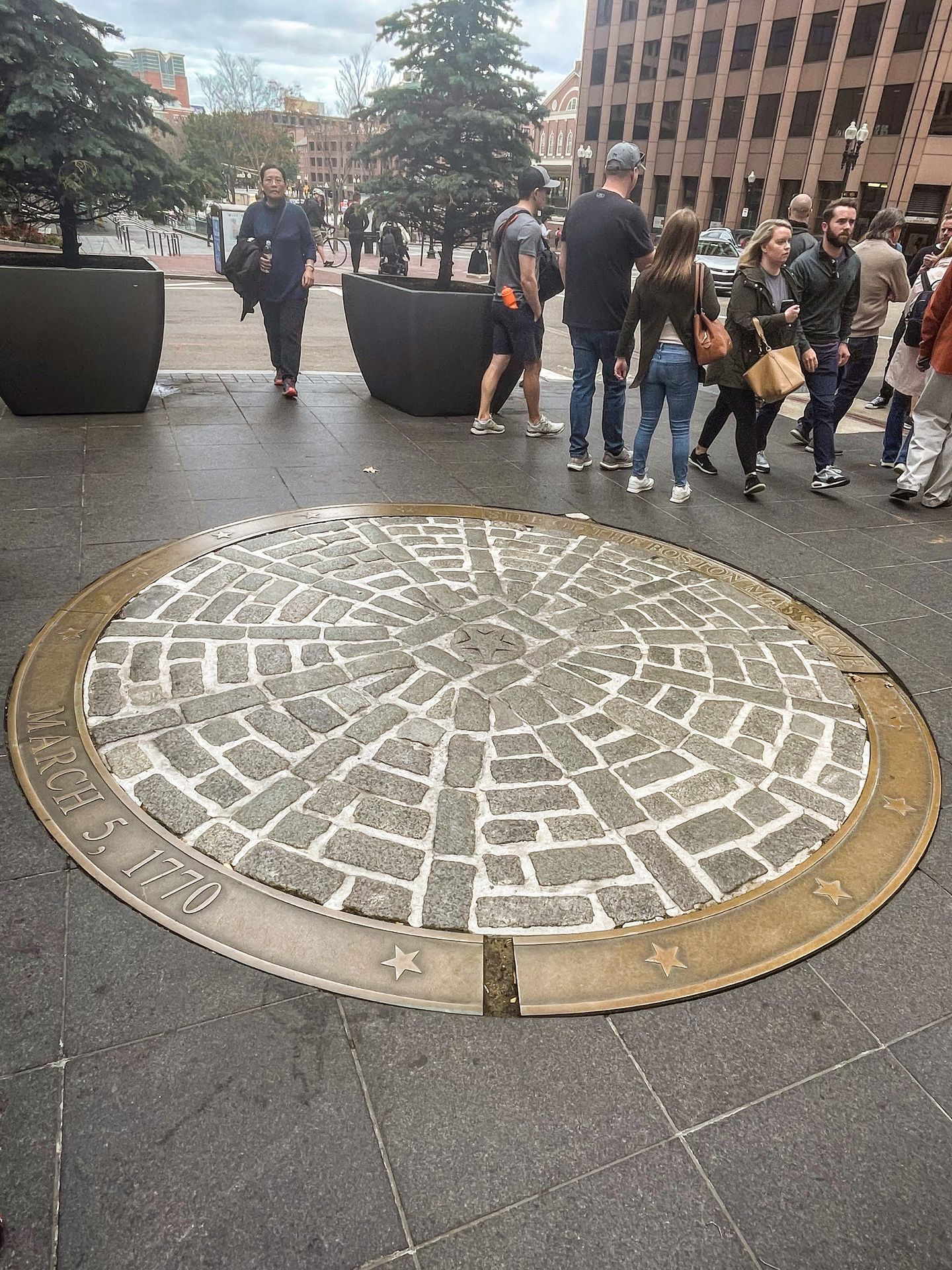
Boston Massacre Site
The Boston Massacre occurred in 1770 when British soldiers fired on a crowd of people, killing five of them. The shots were fired in response to the angry mob throwing stones and snowballs at the soldiers. The image depicting this event was shared widely to garner support for the Patriots.
This event was an important factor in sparking the start of the revolution, as many Bostonians rallied behind the injustice that occurred here.
Today, there is a large marker on the sidewalk where the massacre took place.
Faneuil Hall
Faneuil Hall was a center of commerce and a forum of free speech for many years. It is where the Sons of Liberty discussed their dissent against the British, where Americans first protested the Sugar Act and the site of other important discussions.
Today, The Faneuil Hall Marketplace (next door to the historic Faneuil Hall) includes several vendors where you can purchase a souvenir. This is also where you can pick up a National Park site map of the Freedom Trail and learn more about the trail through some National Park exhibits.
Lunch at Quincy Market or Boston Public Market
Right behind the Faneuil hall Visitor Center, you’ll find Quincy Market. The market first opened in 1823 and is a center for eating and shopping. You can find lobster rolls, clam chowder and much more.


Personally, I found Quincy Market to be way too crowded and overwhelming. The architecture is beautiful, but it gets extremely busy during peak times. With that in mind, I preferred Boston Public Market for lunch.
Boston Public Market is much newer than Quincy Market as it opened in 2015. It includes several New England artisans and a mix of prepared foods, specialty items, crafts and more. I really enjoyed an asiago popover from The Popover Lady for a light lunch.
Boston Public Market also serves fresh pasta, bagels, donuts and more. You’ll likely find it to be a bit more relaxed than Quincy Market.
Dessert in the North End
If you have a sweet tooth, stop to get a cannoli on your way to the next stop on the Freedom Trail. The North End has a large Italian community and is known for its delicious food (more on that later).
After trying cannolis at Mike’s Pastry and Modern Pastry, I highly recommend Modern Pastry to grab a cannoli. Modern Pastry has been family owned and operated for over 80 years. While they have many pastries to choose from, they’ve really perfected their cannolis!
Paul Revere House
Continuing on the Freedom Trail, your next stop is the Paul Revere House. This is where Paul Revere lived and it’s the oldest remaining structure in Downtown Boston.
There isn’t much to see outside, so I paid to go inside. You get to walk through a few rooms in the home and learn a bit about the life of Paul Revere.
You cannot take photos inside but there is a courtyard area where you can. At this writing, tickets are $6 per adult. The museum is small but worth a quick visit for the affordable price.

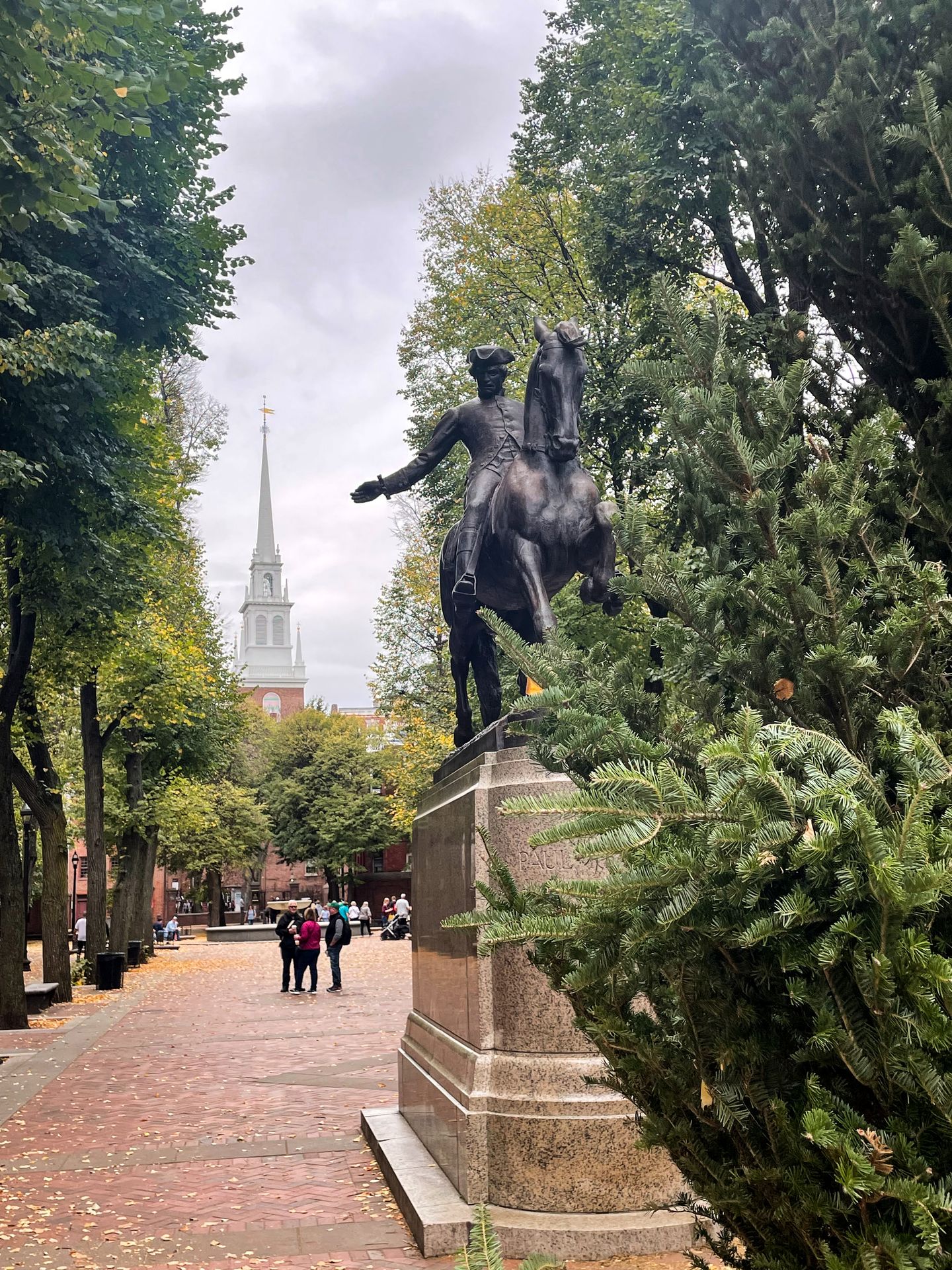
Old North Church
The Old North Church is the oldest church in Boston and is most known as the site where two lanterns were hung to signify that the British were coming during Paul Revere's Midnight Ride.
The church has an affordable entrance fee if you want to explore the interior. The exterior and the park that leads up to the church (Paul Revere Mall) are beautiful either way.
Copp’s Hill Burying Ground
Copp’s Hill will be your last stop before crossing the Charles River into Charlestown! This is the burial site of some important figures who lived on the North End.
It also provides a nice view of the surrounding area. The British used the cemetery as a vantage point to aim their cannons towards Charlestown during the Battle of Bunker Hill.
Tip: Also look for the Skinny House across the street from Copp’s Hill Burying Ground. The house is 10.4 feet at its widest point!
Bonus: Walk across the Gridley Locks Footpath instead of the North Washington Street Bridge
As you continue on the Freedom Trail, the official route will take you over the North Washington Street Bridge. As a slight detour, I recommend walking over the Gridley Locks Footpath instead.

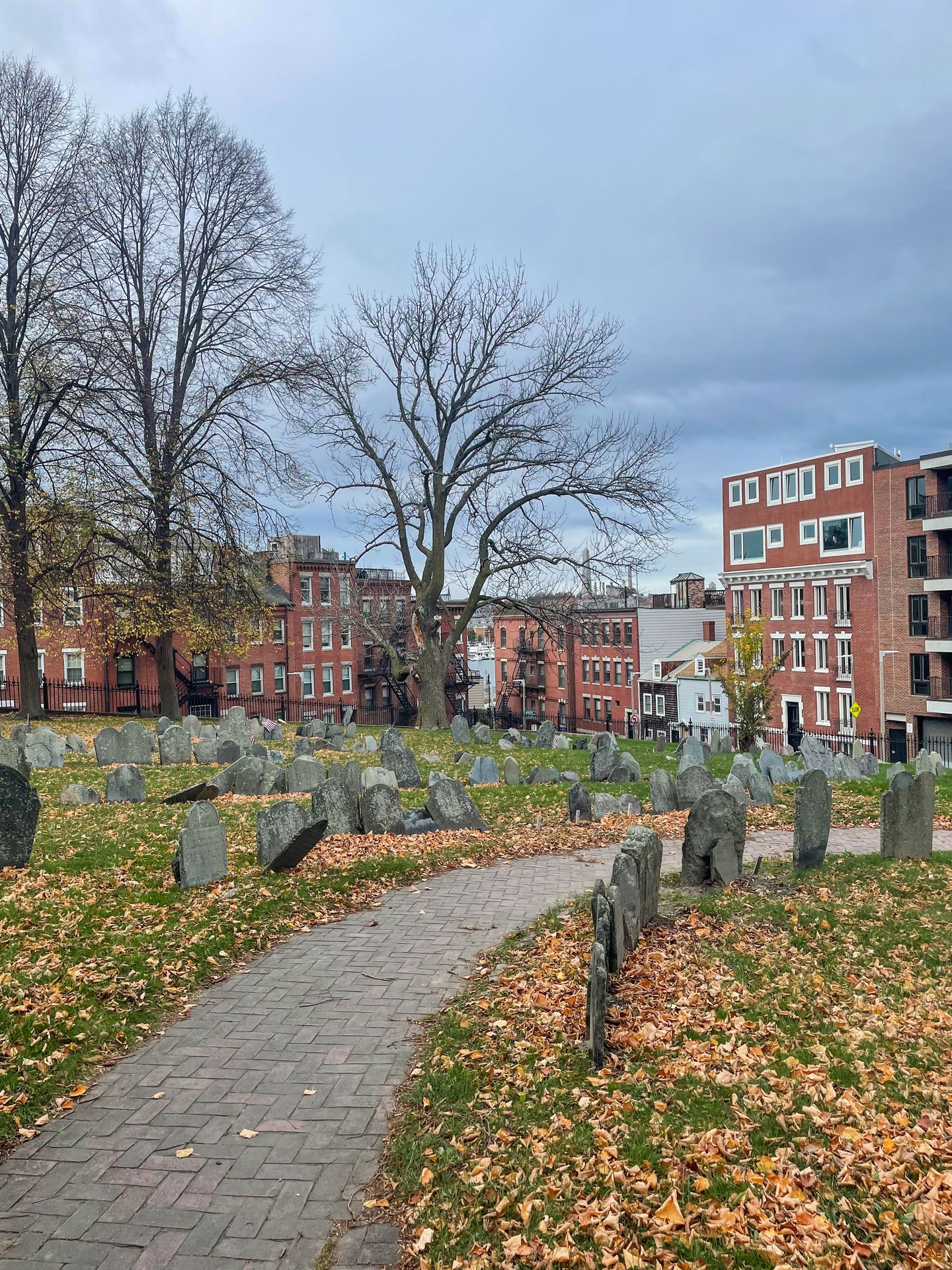
If you’re unfamiliar with a lock, it’s a navigation device to raise and lower boats between different water levels. This lock is still in use as ships navigate between the Charles River and the Boston Harbor.
There is a sidewalk here where you can actually walk over the doors of locks, as long as they are not in use. It feels like you’re not supposed to be there, making it really fun and unique. It’s a great, quick add on to your day walking the Freedom Trail.
USS Constitution
The USS Constitution actually has two parts. There are two ships you can visit as part of a National Park Site and a museum about the USS Constitution next door.
Visiting the National Park Site involves going through security. Then, you’ll begin inside a museum and gift shop area before walking outside to explore both the USS Constitution and the USS Cassin Young.
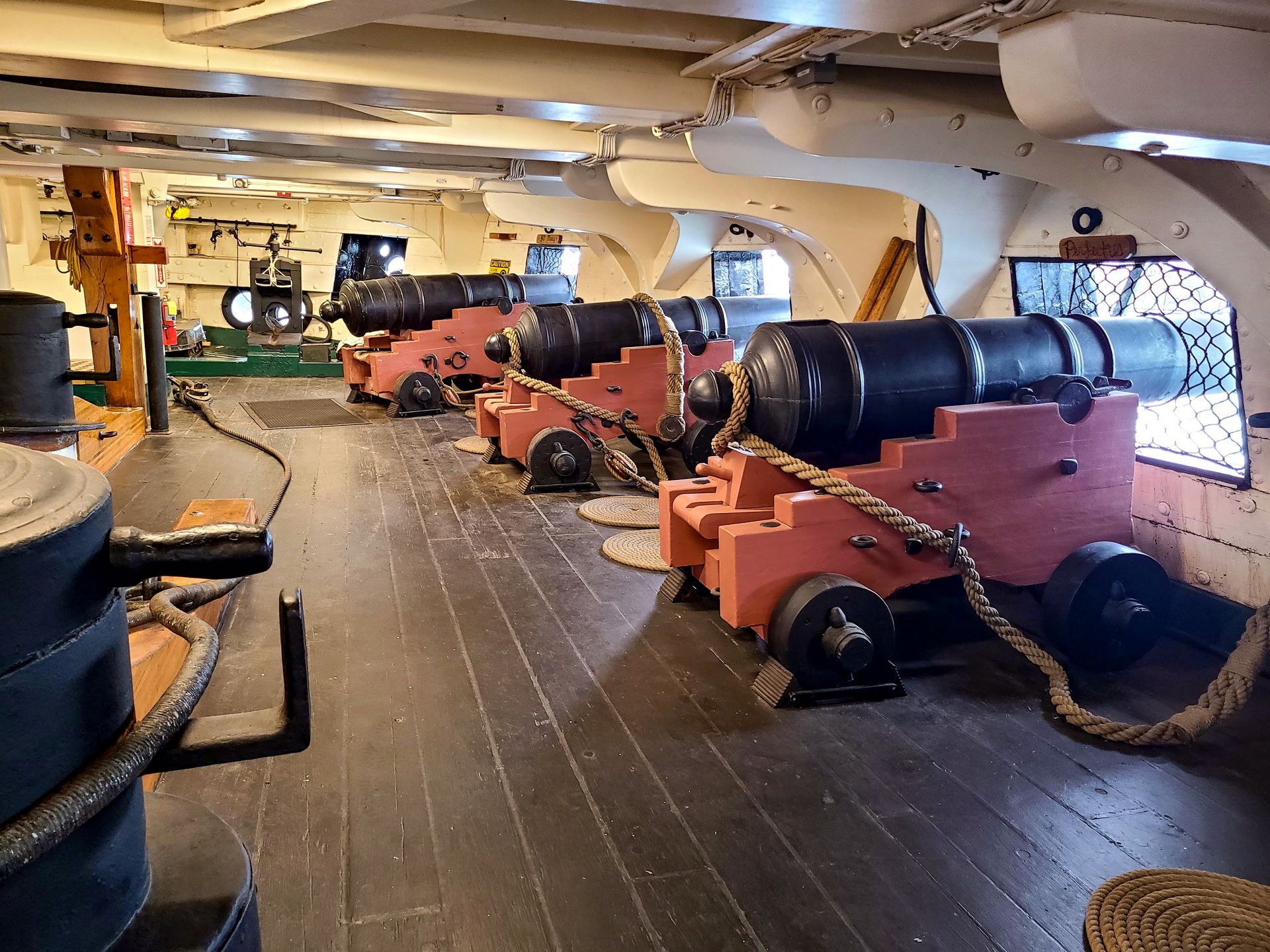
The USS Constitution is the world’s oldest commissioned warship that is still afloat and is still operated by the United States Navy. On board, you can explore three levels and see the cannons, where the soldiers slept and ate, and more. There are steep stairs to descend between the various levels.
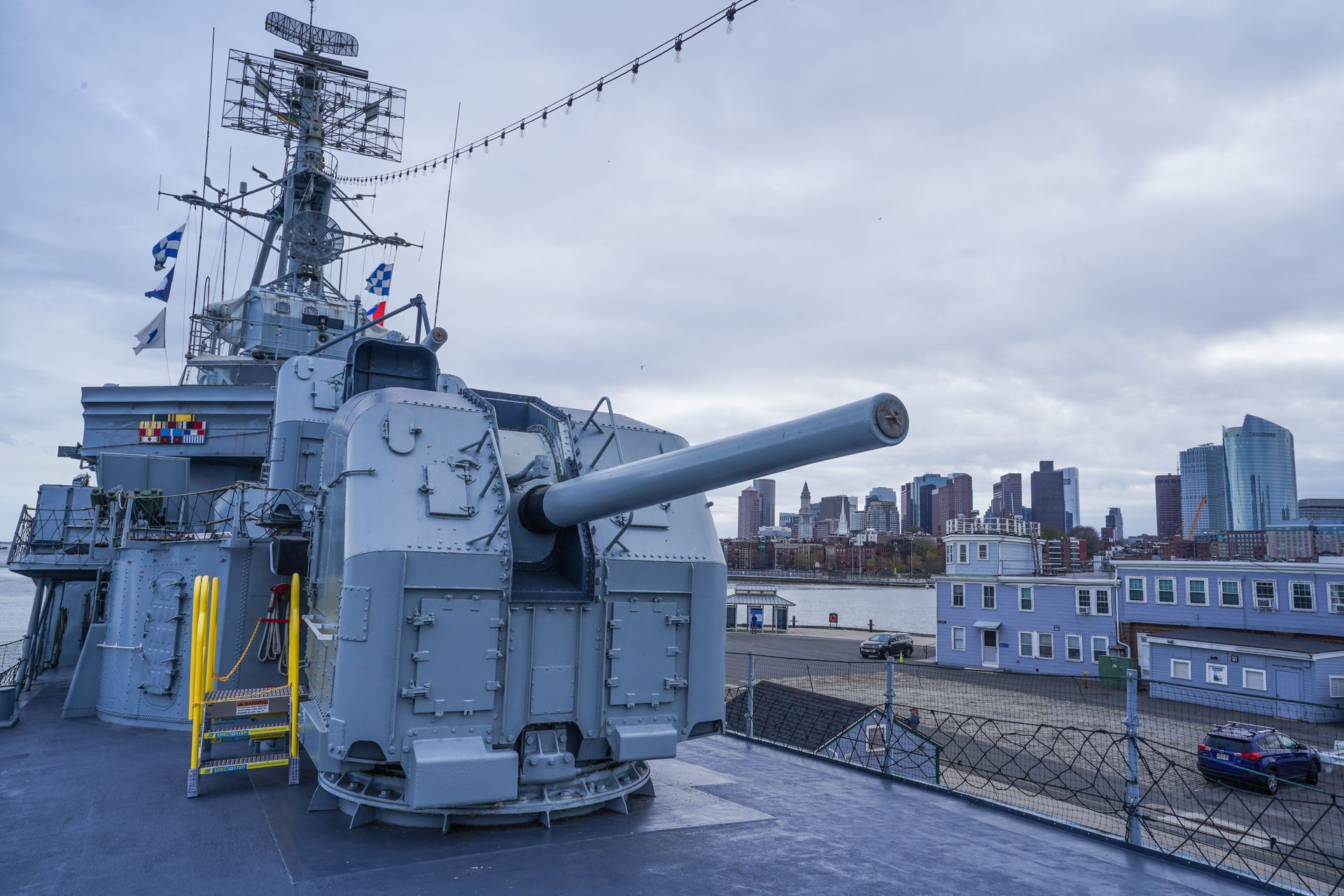
The USS Cassin Young was a destroyer from WWII. It’s interesting to compare this much more modern ship to the USS Constitution.
The USS Constitution Museum is right next to the ships and has exhibits covering the history of the USS Constitution. There are some interesting artifacts to see and some interactive areas great for kids. The museum is donation based but they recommend $10-$15 per person.
Bunker Hill Monument
It’s a bit of a walk to reach our last stop on the Freedom Trail! The Bunker Hill Monument is a half mile away from the USS Constitution.

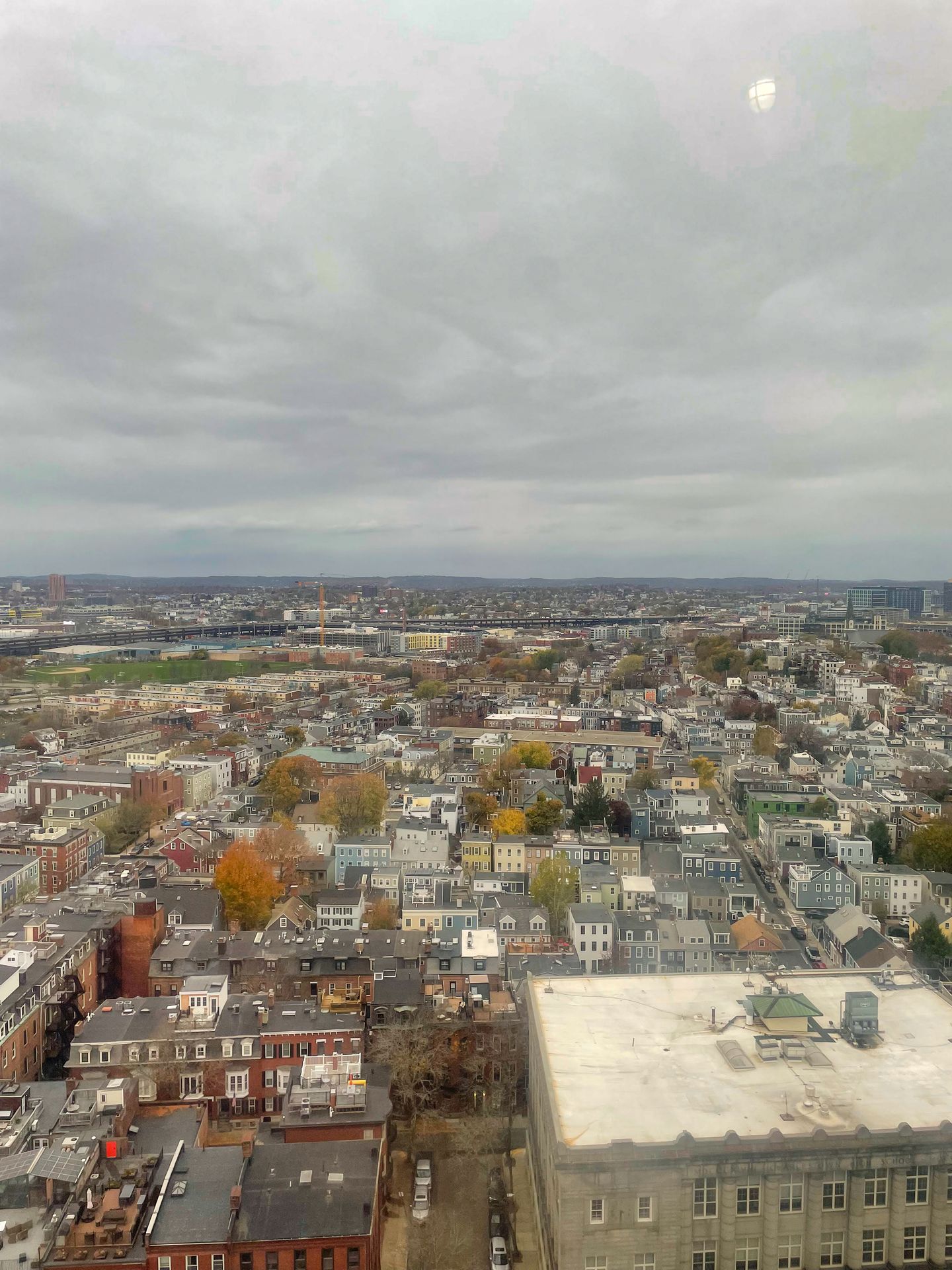
The Bunker Hill Monument honors the site of the Battle of Bunker Hill, the first major battle in the Revolutionary War.
The monument was built 50 years after the battle and is a 221-foot tall obelisk. To reach the top, you’ll climb 294 steps in a bit of a tight and dark staircase.
It’s neat to reach the top, but the windows are small with glass and screens over them, so you won’t get a fantastic view. But it’s still worth climbing up to see for yourself!
The tower is free to visit and there are some artifacts to view at the base of the tower.
Have Dinner in the North End
Enjoy some delicious food after a great day of walking! I recommend taking the train or rideshare to get back from Bunker Hill to the North End.
The North End is known as “Boston’s Little Italy” and is home to some of the oldest buildings in the city. If you like Italian food, this is the perfect area to enjoy some delicious food.
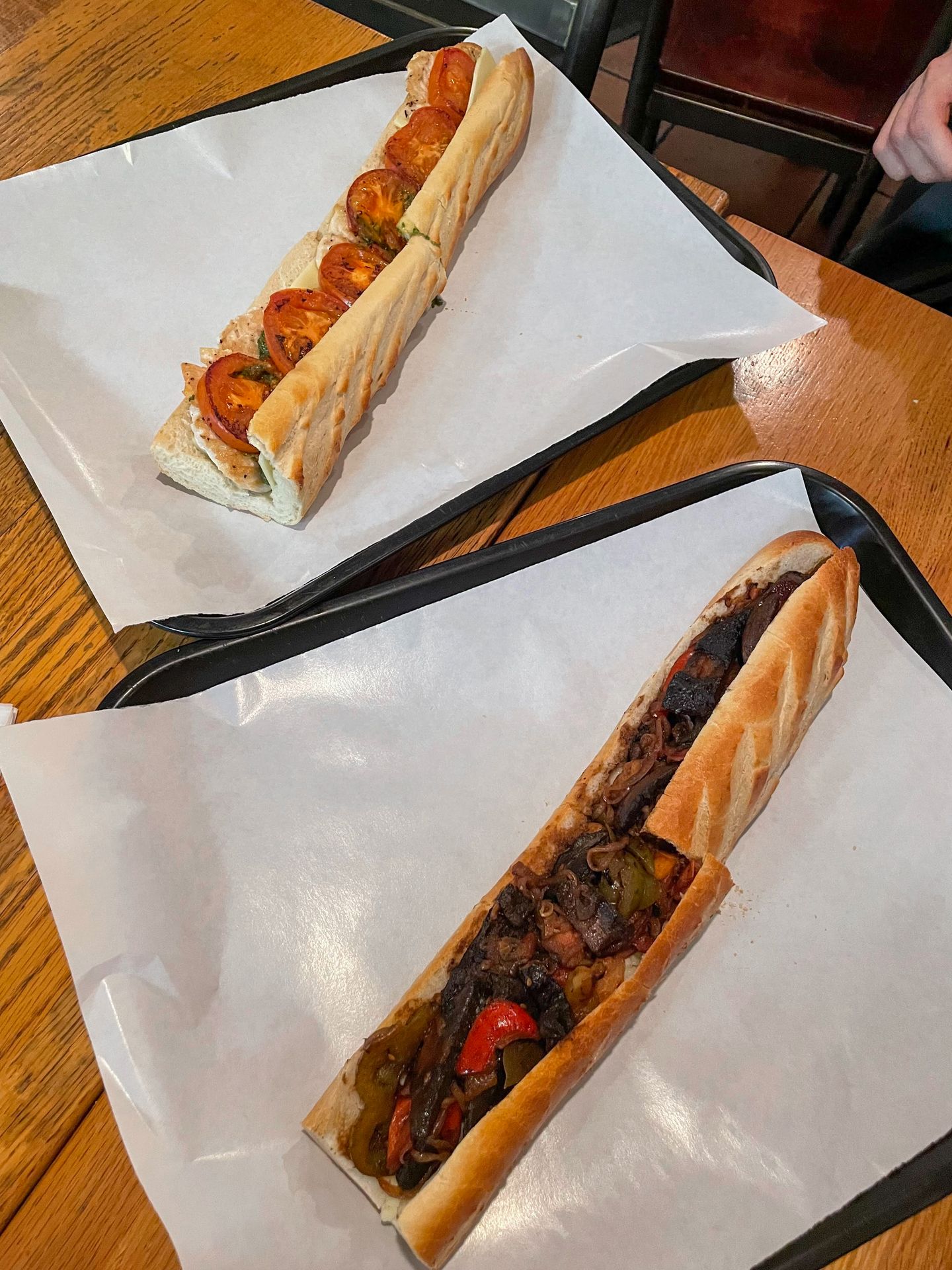
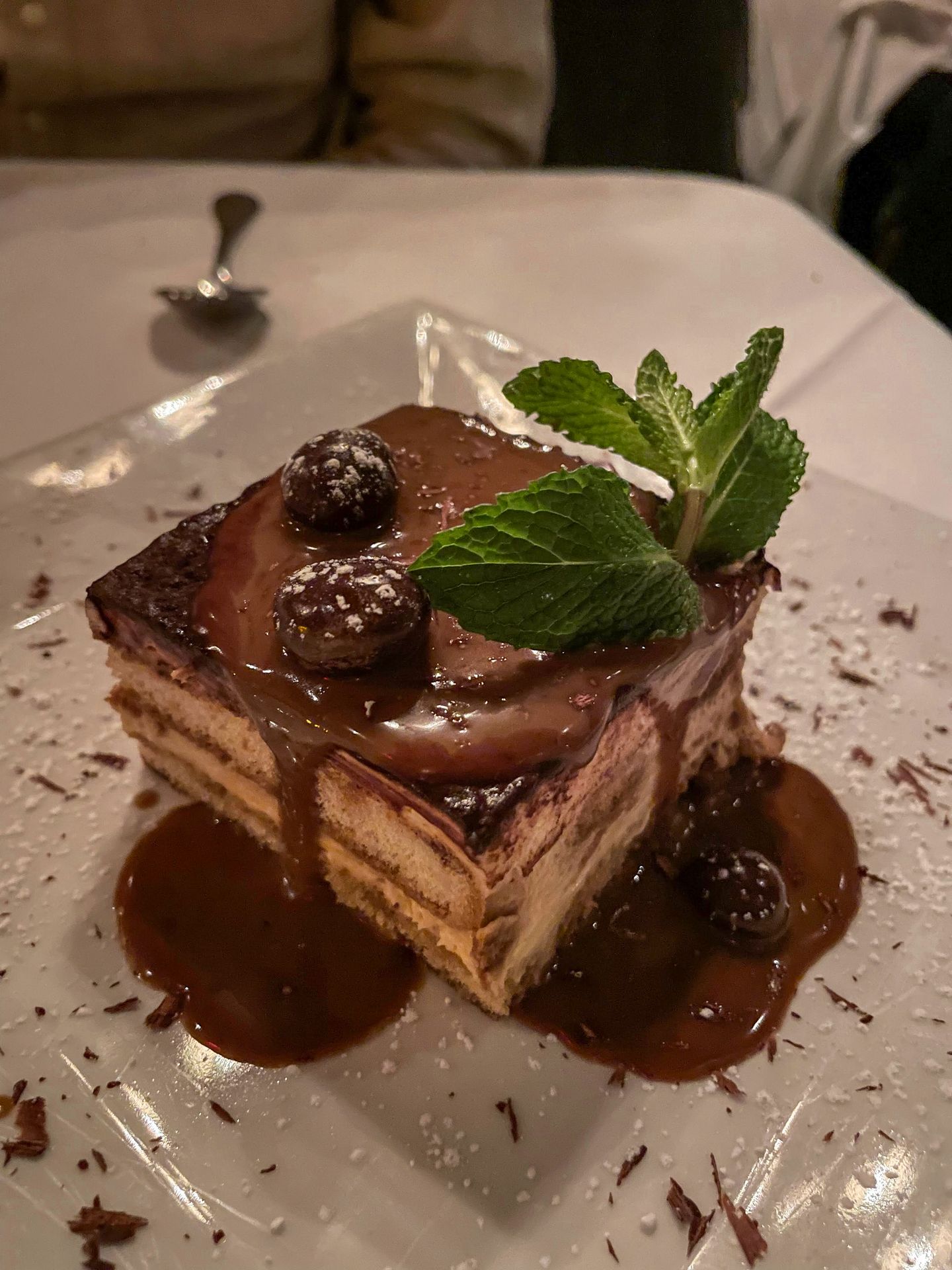
One place I recommend is Dino’s Cafe for their 16 inch Italian subs. The restaurant is small and family owned, and you’ll immediately feel welcome when you enter. I was so impressed with their subs and really enjoyed the vegetarian option. If subs aren’t your thing, they have a large menu full of pastas, salads and other Italian specialties. There is something for everyone here!
Other places to visit in the North End for dinner include Regina Pizza for delicious, thin crust pizza, Trattoria Il Panino for traditional Italian food in a cozy setting and Mamma Maria if you’re looking for fine Italian dining.
For dessert, there is no shortage of places to try. Earlier in the day, I recommended stopping at Modern Pastry for a cannoli. Another great place to go is Caffe Vittoria for indulgent coffee and desserts. Enjoy an espresso martini, tiramisu, gelato or one of their other specialties to finish your day.
Where to Stay in Boston
There are several great hotels close to Boston Commons and the start of the Freedom Trail. These will all be really convenient for this Boston one day itinerary.
The HI Boston Hostel is a modern hostel that offers a mix of shared dorms and private rooms. It’s a great affordable option in the perfect location. This is ideal if you want to make friends during your short Boston trip!
The Revolution Hotel is a trendy and affordable option that has beautiful art and great amenities. They even offer complimentary bikes to explore the city! All of the rooms are private but some include the use of shared bathrooms down the hall.
The Omni Parker House is a historic hotel that is just steps away from stops on the Freedom Trail. This is more high end than the previous two choices. You’ll find a nice restaurant in the lobby and elegant decor throughout the hotel. You can usually find mid-range prices at this 4-star hotel.
Getting Around Boston
Do you need to rent a car in Boston? How is public transportation in Boston? In my experience, the public transportation is very good in Boston and you should not bring a car.
The subway system is relatively fast and easy to navigate, while driving can be very stressful in the downtown area. Rideshare is also easy and quick.
If you are driving to Boston, I recommend staying further outside the city along a train line and taking the train downtown instead of driving. I stayed at this Airbnb in Dorchester and had a great experience (it has plenty of street parking!).
When to Visit Boston
This itinerary includes a lot of time outside, so I recommend avoiding the hottest and coldest months of the year. The best times are either in May and June, or September and October. In September and October, you may also see beautiful fall foliage.
Tip: If you visit near Halloween, check out the beautiful decor on the stoops in Beacon Hill!
I visited in November, and while it was starting to get cold, it still felt like fall and there were few crowds. While there is a risk of snow, November can also be a great time.
If You Have More Time
If you have more than one day in Boston, here are a couple other places to add to your itinerary!
Boston Tea Party Museum
The Boston Tea Party Museum makes a great addition to the Freedom Trail. Visiting the museum is a bit cheesy, but overall it’s really fun. You’ll take a tour from actors in Period clothing and you’ll feel like you are a part of history. The journey begins with an assembly hall meeting and includes throwing tea from the ship into the harbor (it’s attached to a rope).
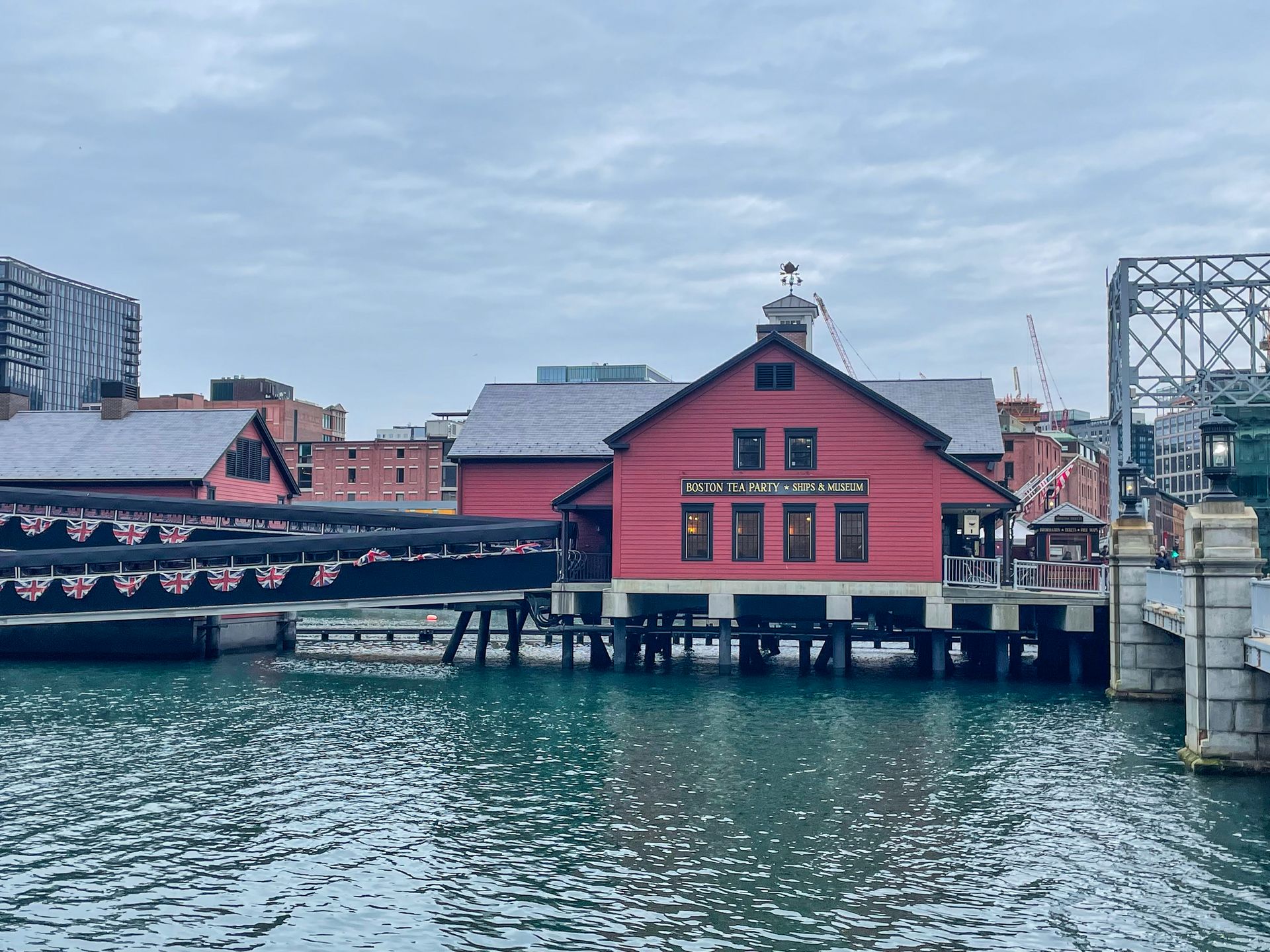
I was very impressed with the videos played inside of the museum. They were high tech and informative on the history that occurred here. At the end of your tour, you can pay a little extra for a tea tasting that includes the traditional teas from this time period. Overall, I recommend the tea party museum for kids (5 and older) and adults alike.
Isabella Gardner Museum
See the impressive museum where a legendary art heist took place at the Isabella Gardner Museum. The museum was built and curated by the eccentric Isabella Gardner, who worked for years to acquire an incredible collection of art. The museum first opened in 1903 and when Isabella died years later, she stipulated that none of the galleries could be changed in the future.


In 1990, an infamous art heist took place here and 13 works were stolen. I highly recommend watching the Netflix documentary This is a Robbery to learn more. None of the artworks were ever recovered and empty frames remain in the Gardner Museum to this day.
If you visit, be sure to reserve a timed ticket in advance.
Final Thoughts
Boston is a must visit city in the US if you love history, art and great food. Whether you visit to take a step back in time on the Freedom Trail or to enjoy the delicious Italian food at the North End, there is something for everyone. I hope this one day guide Boston helps you plan your trip!
More New England and New York Guides:
- How to Spend One Day in Salem, MA
- An Epic 10 Day New England Road Trip
- The Best Hiking near Ithaca, New York
- 7 Day Vermont and New Hampshire Fall Itinerary
- The Best Hiking Trails in Acadia National Park
- The Ultimate Fall Guide to Acadia National Park
- The Perfect Day Trip to Connecticut
- The Best Things To Do in North Adams, MA
Thanks for Reading!
Let's stay in touch!
Join the Lost with Lydia email list to get monthly travel guides and tips!

